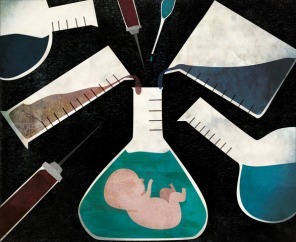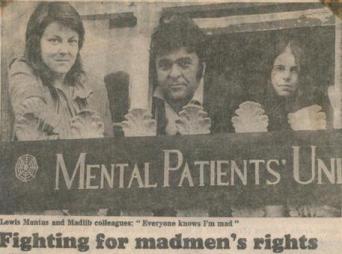Reading Marge Piercy’s “Woman on the Edge of Time” in 2021
A friend of mine recently came out to me as nonbinary, someone I’d known as a gentle, bearded man. The beard is gone, but there doesn’t seem to be any essential difference in demeanor. The friend now wears pastel V-necked T-shirts, gets manicures, and has longer hair, but is otherwise the person I’ve know for years. Maybe a name is now available for an identity that had been there from the start.
You might notice, gentle reader, that I’m avoiding the pronoun “they” as singular. My sister’s kid— I now know the extremely useful term for non-binary niece or nephew, nibbling—has gone by “they” for a while now, but I’d rather use a pronoun that was asserted forty-five years ago: per.
As in: my friend likes to tie per long curls back, and joins per partner for a manicure. Per V-necked T-shirts are brighter than the ones per used to wear.
 I’m getting this pronoun—and everything else I’ll write about here—from Marge Piercy’s 1976 novel Woman on the Edge of Time.
I’m getting this pronoun—and everything else I’ll write about here—from Marge Piercy’s 1976 novel Woman on the Edge of Time.
The premise is a very 1976 one. Courageous, depressed and desperate Connie Ramos bashes her niece’s pimp on the head with a bottle, and ends up committed to a mental hospital, where she’s thrown into the violent ward and doped up on Thorazine. She’s also in contact with Luciente, an emissary from 2137 who introduces her to a communitarian society where a revolution has eliminated economic, racial and gender inequalities.
In fact, there is no defined gender in the utopia of Woman on the Edge of Time. Unlike our “they”, the pronoun, “per” carries no particular associations about gender nonconformity. It’s used universally. I should note that because the novel is anchored in Connie’s point of view, she identifies the people she meets as men or women, but as far as the characters themselves are concerned, their penises or vulvas aren’t defining: they’re a source of play and pleasure. There’s plenty of sex in 2137, and no names for distinct sexual orientations. Passions aren’t orientations. Per loves whom per loves.
It take a while for Connie Ramos to get her mind around all this, of course, and as Connie learns, the liberation comes at a price. At one point, Connie is led to a humming, mushroom-shaped chamber that enclooses an aquarium—the “brooder” where embryos grow. It’s a vision similar to Huxley’s Brave New World, but Huxley’s embryos are genetically modified to create a fixed caste system. In this case, the aim is quite the opposite. Luciente’s explanation is worth quoting at length:
at a price. At one point, Connie is led to a humming, mushroom-shaped chamber that enclooses an aquarium—the “brooder” where embryos grow. It’s a vision similar to Huxley’s Brave New World, but Huxley’s embryos are genetically modified to create a fixed caste system. In this case, the aim is quite the opposite. Luciente’s explanation is worth quoting at length:
“It was part of women’s long revolution. When we were breaking all the old hierarchies. Finally there was that one thing we had to give up too, the only power we ever had. In return for no more power for anyone […] Cause as long as we were biologically enchained, we’d never be equal. And males never would be humanized to be loving and tender’”
Once “born”, the children have three co-mothers, a term which, of course, has no connection to bearing children. Connie—and perhaps the reader—recoils in disgust when a man opens his shirt to breast-feed. It’s all so planned, she thinks, so artificial.
The embryo-brooder and male breastfeeding are not the only artificial elements in Piercy’s 2137. Connie is told that Luciente and the others in the village are Wampanoag Indians. They’re light-skinned, dark-skinned, bearded, clearly of African, European, Asian and Mexican descent, but Wampanoag Indian is their “tribe.” All of the villages have tribes: Ashkenazi Jewish, Harlem Black and so on, a way to preserve cultural traditions while “breaking the bond between genes and culture” so there would be “no chance of racism again.” Yes, people are raised in a tribe, but they can also switch tribes (which are also called “flavors”). Black members of Luciente’s tribe could move into the Harlem Black village any time they chose. Presumably so could Rachel Dolezal.
Luciente and the others in the village are Wampanoag Indians. They’re light-skinned, dark-skinned, bearded, clearly of African, European, Asian and Mexican descent, but Wampanoag Indian is their “tribe.” All of the villages have tribes: Ashkenazi Jewish, Harlem Black and so on, a way to preserve cultural traditions while “breaking the bond between genes and culture” so there would be “no chance of racism again.” Yes, people are raised in a tribe, but they can also switch tribes (which are also called “flavors”). Black members of Luciente’s tribe could move into the Harlem Black village any time they chose. Presumably so could Rachel Dolezal.
So how do we read Woman on the Edge of Time in 2021? Is this novel a utopian vision, or a dystopia where language enforces a kind of nonbinary conformity, and racial and ethnic identity is reduced to a cafeteria of “flavors”? It’s also worth noting that history itself is deliberately scrambled: one of the culture’s many holidays celebrates the anniversary of the Seneca Falls conference where Harriet Tubman delivered her famous “Ain’t I a Woman” speech, after which she stormed the Pentagon. In celebration, children smash a paper pentagon, and there’s candy inside. I think I was supposed to be charmed. Instead, frankly, I felt seasick.
Piercy appears to hedge her bets. When we meet a member of the Harlem Black tribe, she is, in fact, Black, and Connie is relieved to meet a fellow Latina whose village on the Texas border At some point, we learn that Cree land remains protected, and presumably, it is a place for actual members of the Cree Nation. In fact, Connie herself expresses many of a reader’s possible misgivings, a useful narrative device. Not everything’s resolved.
You’ll have to read the novel for yourself. It’s still in print. What I write here doesn’t include many other elements o f Woman on the Edge of Time: Connie’s experiences in the mental hospital as the subject of a sinister experiment, her complex, tragic past, the Wizard of Oz parallels between her fellow inmates and characters in the 2137 future, the war between two alternative futures and Connie’s role in that war, and of course, the possibility that everything is a hallucination.
f Woman on the Edge of Time: Connie’s experiences in the mental hospital as the subject of a sinister experiment, her complex, tragic past, the Wizard of Oz parallels between her fellow inmates and characters in the 2137 future, the war between two alternative futures and Connie’s role in that war, and of course, the possibility that everything is a hallucination.
Who reads this novel now? We all should. I have decided that nonbinary people are emissaries from the future. What about other binaries and social constructs? Are they hallucinations too?



